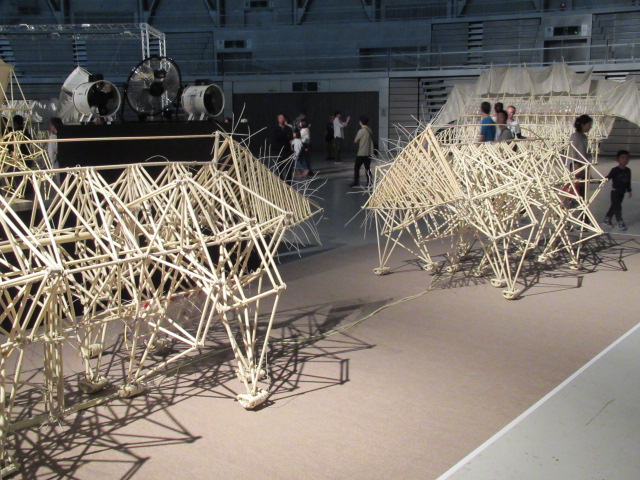
September/22/2019
Theo Jansen is a world-renowned Dutch artist who is often called a modern-day Leonardo da Vinci.
He’s particularly famous for his Strandbeests, walking artworks that combine science and art. Strandbeests means “beach animals” in Dutch. The animals
Fifteen Strandbeests were recently exhibited in Fukui Prefecture, and two of them had been made with Echizen Washi, a variety of Japanese paper that’s made in Fukui Prefecture and that has a 1,500-year history. Theo Jansen also gave a special talk.
Five minutes before the opening time I went to the venue, where 50 people were already standing in line. One of the people in front of me said that he’d seen some of Jansen’s artworks in an art textbook from a particular school.




When I went into the venue I first saw some of his sketch notebooks. The sketches had been drawn very precisely, and this is because he’s also a painter. I was also able to touch some of the plastic tubes that are the major components of the Strandbeests. The tubes were hollow and lighter than I’d expected.


Next I was able to operate by hand a Strandbeest called Animaris Ordis. The beest had been made for the automobile company BMW to use in TV commercials. One of the people who had operated it before me said that it was great. When I pushed on it, I was surprised by how heavy it was. I felt the vibration of the beest travel all the way up to my hands. Its numerous legs moved in an orderly way, and that was mysterious.




Then Jansen did a “reanimation” of the Strandbeests, which meant bringing them to life. A lot of people gathered around a particular beest called Animaris Omnia Segunda. When I first saw Jansen I was struck by his intelligent face. He explained that the Strandbeests point their heads toward the wind just as seagulls do their beaks. I learned that Strandbeests have sensors that detect water and sand. Surprisingly, the



I was happy that I was able to see it being moved by a wind.







When Jansen was finished giving his explanations, I walked around and saw some other beests.


I saw Animaris Ordis Quartus, the other work made with Echizen Washi. The washi in both of these beests was made by Hideaki Taki. He says that it was difficult to make it strong enough for them. These were the first Strandbeests in the world to be made with the help of a traditional Japanese craft.


Finally I listened to a special talk by Theo Jansen.
He’s sometimes asked whether he’s a scientist or an artist, and he always answers that he’s an Eskimo. He mentioned this during his talk and explained that Eskimos have a high level of technology and make great artworks, but that they don’t think of themselves as scientists or artists.
He said that he was an optimist, and that that was how he’d been able to make the Strandbeests that we’d seen that day. He said that at first he hadn’t been able to make walking Strandbeests,but that they’d evolved gradually. He advised young people to keep doing what they liked without thinking about the results, something he was able to recommend based on his own experience.
Lastly he said that he wanted everyone to see his Strandbeests and experience the miracle of life through them.
His speech gave me the sense that he saw his creations as real creatures. Strandbeests are unique, and I was amazed by his creativity. I’m looking forward to seeing how the Strandbeests continue to evolve.
In my next entry I’m going to write about Echizen Washi.
